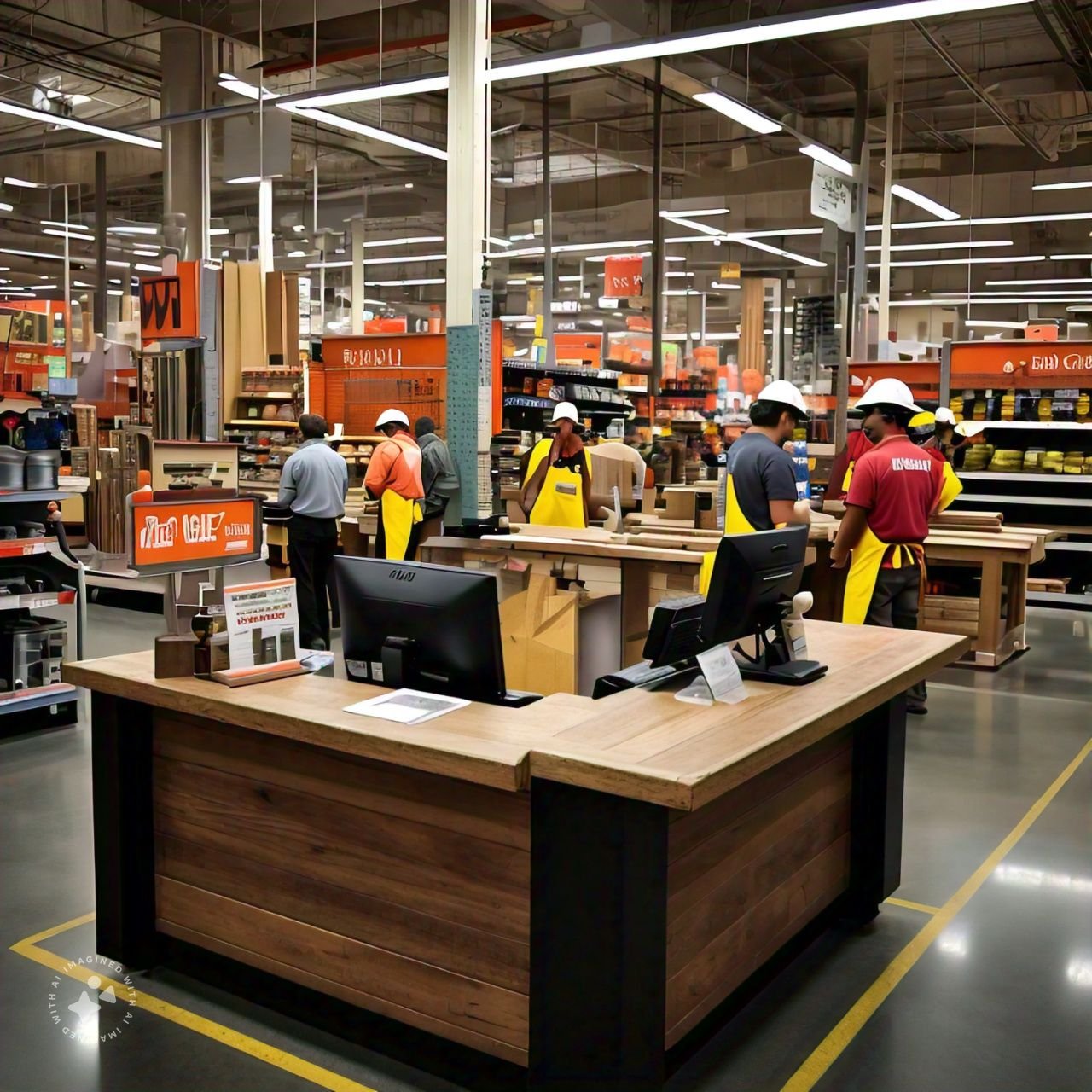Home Depot is one of the largest home improvement retailers in the world, offering a vast range of products and services for both professional contractors and DIY enthusiasts. Founded in 1978, the company has grown into a global leader in the home improvement market. This 2,000-word overview explores Home Depot’s history, business model, product offerings, innovations, and challenges, along with its contributions to society and the environment.
History and Foundation of Home Depot
Home Depot was founded in 1978 by Bernie Marcus and Arthur Blank, who had a vision to create a one-stop shop for home improvement products, offering customers everything they needed under one roof. Their goal was to cater to both professional contractors and DIY customers by providing a wide selection of products at competitive prices. The first two stores were opened in Atlanta, Georgia, in 1979, and each store was designed to be massive—around 60,000 square feet—which was unheard of for a retail store at that time.
The concept quickly gained popularity, and by the mid-1980s, Home Depot had expanded across the United States. The company went public in 1981, which allowed it to raise capital to fuel its rapid growth. Home Depot’s emphasis on customer service, knowledgeable staff, and a wide range of products helped it differentiate itself from competitors.
Business Model and Strategy
Home Depot’s business model revolves around the concept of a “big-box” retailer, offering a large variety of home improvement products, tools, appliances, and building materials. The company’s stores are typically large warehouse-style spaces that allow customers to easily browse thousands of products.
- Customer Focus: Home Depot caters to both professional contractors and individual consumers. By offering a wide selection of products at various price points, the company appeals to a broad customer base. The retailer also emphasizes customer service, employing knowledgeable staff who can offer advice on projects and product use.
- Product Variety: Home Depot carries a wide range of products, including hardware, electrical supplies, plumbing materials, tools, paint, and outdoor equipment. It also offers home appliances, lighting fixtures, and seasonal products such as garden supplies and holiday decorations.
- Competitive Pricing: Like many large retailers, Home Depot uses its scale to negotiate lower prices with suppliers. This allows the company to offer competitive pricing to its customers, making it an attractive option for budget-conscious shoppers.
- In-Store Experience and DIY Culture: Home Depot promotes a strong DIY culture, offering in-store workshops and how-to classes. These classes teach customers how to tackle home improvement projects themselves, which helps to drive sales of related products. The in-store experience is designed to be hands-on, with employees ready to assist customers in choosing the right tools and materials for their projects.
- Online Sales and Omnichannel Strategy: Home Depot has successfully integrated its in-store and online shopping experiences. Customers can browse and purchase products online, with the option of in-store pickup or home delivery. This omnichannel approach ensures that customers can shop in the way that’s most convenient for them.
Global Expansion and Reach
Although Home Depot primarily operates in North America, with the majority of its stores in the United States, it has expanded internationally over the years. Home Depot has stores in Canada and Mexico, where it has seen significant success.
However, its foray into international markets has not always been smooth. Home Depot entered the Chinese market in 2006, but it struggled to gain traction there. The Chinese market proved difficult for Home Depot’s DIY-focused model, as Chinese consumers were more inclined to hire professionals for home improvement projects. In 2012, Home Depot closed its last seven stores in China, marking its exit from that market.
Despite challenges in certain regions, Home Depot remains committed to its presence in North America, where it continues to expand its store footprint and online presence.
Products and Services Offered
Home Depot is known for its wide variety of products, which cover virtually every aspect of home improvement and maintenance. Here are some of the main product categories and services offered by Home Depot:
- Building Materials: This includes lumber, drywall, insulation, cement, and roofing materials. Home Depot is a go-to retailer for professional contractors working on construction or renovation projects.
- Tools and Hardware: Home Depot carries a wide selection of power tools, hand tools, and hardware supplies. From drills and saws to hammers and nails, Home Depot has tools for both professionals and DIYers.
- Plumbing and Electrical Supplies: Customers can find a vast array of plumbing fixtures, pipes, faucets, and water heaters, as well as electrical supplies such as wiring, outlets, and lighting fixtures.
- Paint and Home Decor: Home Depot offers a broad selection of paints, stains, and painting supplies. Customers can also find flooring, carpeting, blinds, and other home décor items to complete their renovation projects.
- Appliances: Home Depot carries major home appliances such as refrigerators, dishwashers, washers, dryers, and ovens. The company offers both high-end and budget-friendly options.
- Garden and Outdoor: Home Depot is also known for its garden center, which offers plants, seeds, gardening tools, patio furniture, and outdoor power equipment like lawnmowers and leaf blowers.
- Installation Services: For customers who prefer professional help, Home Depot offers installation services for many of its products, such as flooring, cabinets, water heaters, and windows.
- Rental Services: Home Depot also rents out tools and equipment for short-term projects. This service is particularly useful for contractors and DIYers who need specific tools for one-time use but don’t want to make a permanent purchase.
Technological Innovations
As with most large retailers, Home Depot has embraced technology to improve both customer experience and operational efficiency. The company has made several innovations to stay competitive in the digital age:
- Online Shopping and Mobile App: Home Depot’s website and mobile app provide customers with an easy and convenient shopping experience. The app allows customers to browse products, check store inventory, and place orders for delivery or pickup. It also offers features like voice search, barcode scanning, and AR-based product visualization.
- Omnichannel Strategy: Home Depot has embraced an omnichannel strategy, which integrates online and in-store shopping. Customers can purchase products online and pick them up in-store, or they can have products delivered to their homes. This approach has been particularly effective during the COVID-19 pandemic, as more customers opted for contactless shopping methods.
- Supply Chain and Inventory Management: Home Depot uses sophisticated inventory management systems to ensure that products are always available when customers need them. The company has invested in automation and robotics at its distribution centers, improving the speed and accuracy of its supply chain operations.
- Pro Xtra Program: Home Depot’s loyalty program, Pro Xtra, is designed for professional contractors and builders. Members of the program receive discounts, exclusive deals, and access to job site delivery services. The program also provides digital tools to help contractors manage their projects and track expenses.
Challenges Facing Home Depot
Despite its enormous success, Home Depot faces several challenges in the modern retail landscape.
- E-commerce Competition: Although Home Depot has made significant strides in e-commerce, it faces strong competition from online retailers like Amazon, which has disrupted traditional brick-and-mortar retail. Home Depot’s challenge is to continue expanding its online presence while maintaining its in-store experience.
- Labor Shortages: The home improvement sector, like many industries, has been affected by labor shortages. Skilled labor, particularly in areas like installation services, is in high demand, and Home Depot must compete with other companies to attract and retain talent.
- Supply Chain Disruptions: Global supply chain disruptions, particularly during the COVID-19 pandemic, have affected Home Depot’s ability to stock certain products. Delays in shipping and shortages of raw materials have impacted product availability and pricing.
- Environmental Concerns: Home Depot, as a major retailer of products made from natural resources like lumber, faces increasing pressure to address environmental concerns. The company has made strides in sustainability, but it must continue to focus on reducing its environmental footprint, from sourcing materials to energy consumption in its stores.
- Adapting to Changing Consumer Preferences: Consumers are increasingly interested in sustainable products and eco-friendly home improvement solutions. Home Depot must continue to expand its offerings in these areas to meet growing demand for green products.
Sustainability and Corporate Social Responsibility
Home Depot has taken steps to address sustainability and corporate social responsibility (CSR), recognizing its role as a major player in the global economy and its responsibility to reduce its environmental impact.
- Sustainable Sourcing: Home Depot is committed to sourcing wood and other materials from sustainable sources. The company has a policy in place to prevent deforestation and promote responsible forestry practices. Home Depot also encourages suppliers to use recycled and eco-friendly materials whenever possible.
- Energy Efficiency: Home Depot has made efforts to reduce energy consumption in its stores. Many of its locations have been retrofitted with energy-efficient lighting, and the company is investing in renewable energy sources, such as solar panels, to power its operations.
- Recycling Programs: Home Depot offers recycling programs for products such as batteries, compact fluorescent bulbs, and old appliances. The company also promotes recycling in its own operations, reducing waste and encouraging customers to recycle their old products.
- Community Involvement: Home Depot is actively involved in supporting communities, particularly in the areas of affordable housing and disaster relief. Through its foundation, the company donates millions of dollars each year to build homes for veterans, improve neighborhoods, and assist in disaster recovery efforts.
Future Outlook for Home Depot
Looking to the future, Home Depot is well-positioned to continue its leadership in the home

